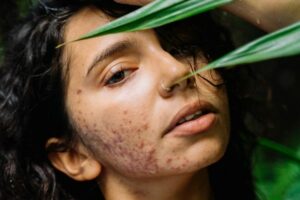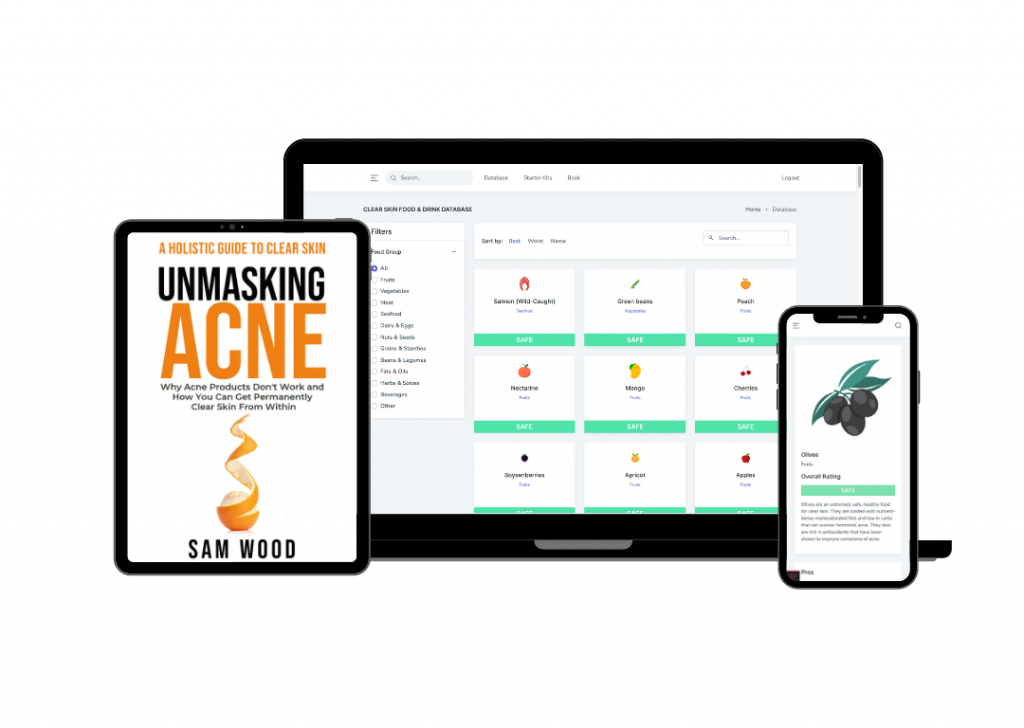Acne marks and acne scars are two terms used interchangeably to describe the result of acne on the skin.
And while there is a slight difference between their meaning, both are caused by various degrees of inflammation on the skin.
Sometimes, this inflammation leads to pigmentary issues, and other times, it goes even deeper than that, protruding into the dermal layer of the skin and damaging its capacity to produce collagen in certain areas.
So, what’s caused by what? And, more importantly, how do we treat them? In this article, we will explain everything you need to know about the difference between acne marks and acne scars and what you need to do to get rid of them.
What Are Acne Marks?
Acne marks are lesions that remain on the skin after a pimple has healed and are characterized by excessive pigment or the complete lack of it.
There are three types of acne marks, each with their own unique set of characteristics:
Hyperpigmentation (Brown Spots)
Hyperpigmentation, or brown spots, are types of scarring that occur when the inflammation caused by an overgrowth of bacteria inside the pores of the skin triggers the melanocytes, which are cells responsible for producing the brown pigment melanin, into overdrive.
The free pigment is then engulfed by macrophages, now called melanophages, in the upper dermis and produces a blue-gray appearance to the skin at the site of injury or, in the case of acne, where the pimple was.
The result is an accumulation of melanin in the area around the pimple, which leads to the formation of a dark spot.
Hypopigmentation (White Spots)
Hypopigmentation, or white spots, is a complete loss of pigment at the site of injury, trauma, or where the pimple was.
Although quite rare, hypopigmented spots can sometimes occur due to picking the pimple, which can damage the tissue and the cells responsible for producing melanin.
This type of scarring may start out brown or pink but can fade to white over time.
Erythema (Red Spots)
Post-inflammatory erythema or red spots are usually the results of a broken blood vessel under the skin’s surface that has ruptured due to a deep cystic pimple that has damaged the lower layers of the epidermis.
This type of scarring tends to occur in those with light skin tones and is notoriously difficult to treat. It can also last significantly longer than hyperpigmentation, as the blood vessels need time to heal so that the redness dissipates.
What Are Acne Scars?
Acne scars are lesions that remain on the skin after a pimple has healed and are characterized by a change in the skin’s texture.
Atrophic acne scars are some of the most common types of scars that occur when inflammation from acne triggers the destruction of collagen, leaving an indentation in the skin.
There are several types of atrophic scars, each with their own set of characteristics:
Icepick Scars
Icepick scars are deep, narrow, and jagged scars that look like enlarged pores. Usually prominent in the cheek area, they can be quite difficult to treat and tend to require multiple rounds of various professional treatments to disappear entirely.
Boxcar Scars
Boxcar scars are broad, U-shaped depressions in the skin with well-defined edges. They can be shallow or deep and are most commonly found on the cheeks, temples, and jawline.
However, although they tend to look more menacing than icepick scars, they are easier to treat and can often be taken care of with a few rounds of professional treatments and even be improved with some skincare products.
Rolling Scars
Rolling scars are broad depressions in the skin that have poorly defined edges and give the skin a rolling or wave-like appearance.
They are most commonly found on the cheeks and jawline but can also pop up on the forehead and chin.
Rolling scars are more shallow than icepick scars; however, they can be challenging to treat due to their length and undefined edges, and visible results often require multiple rounds of professional treatments.
Treatment Options for Acne Marks
Acne marks, although superficial, can definitely require a lot of patience and dedication to fully fade.
However, even though getting rid of this type of discoloration might take some time, you’re not without options that can help you achieve results faster.
Here are some excellent treatment options for acne marks:
Over-The-Counter Melanin Inhibitors
Melanin inhibitors are ingredients in skincare products that help block the overproduction of melanin and can help fade dark spots left behind by acne.
Some excellent melanin inhibitors found in easily accessible and affordable over-the-counter products are:
- Vitamin C.
- Niacinamide.
- Azelaic acid.
- Arbutin.
- Kojic acid.
- Tranexamic acid.
Exfoliation
Exfoliation helps the outer layers of the skin to shed faster, which can help speed up the fading process of dark spots as new skin cells are brought to the surface.
Some excellent exfoliating ingredients that help brighten dark spots are:
- Glycolic acid.
- Lactic acid.
- Enzymes.
Retinoids
Retinoids are vitamin A derivatives that work by speeding up cellular turnover and encouraging the production of collagen.
They are available in both prescription and over-the-counter formulas and can help improve all types of acne marks, including hyperpigmentation and red spots left from acne, which are notoriously difficult to treat.
Chemical Peels
Chemical peels are professional treatments that include the usage of strong exfoliating acids to help improve the appearance of acne marks and uneven skin texture.
These are essentially more potent versions of at-home exfoliating acids and should be performed by a licensed professional.
Downtime is usually quite common with chemical peels, as the skin will be left red and raw-looking for several days after the treatment, and peeling can last up to a week or more, depending on the strength of the ingredients.
Treatment Options for Acne Scars
Acne scars are permanent changes to the texture of the skin and, as such, are much more challenging to treat than acne marks.
And since topical treatments can do very little to improve these lesions, your best options are professional procedures that will help stimulate collagen production and reconstruct the skin.
Some excellent treatment options for acne scars are:
Microneedling
Also known as collagen induction therapy, microneedling uses either a fine-needle roller or a pen device to create tiny holes in the top layer of the skin.
The procedure stimulates collagen production, which helps improve atrophic acne scars after as little as 2-3 treatments.
Laser
Lasers are definitely one of the best treatments you can get to remove both acne scars and pigmented acne marks.
They work by creating controlled damage on the skin’s surface in order to stimulate the skin to heal itself by producing new collagen and elastin.
Laser treatments are the most efficient treatment for repairing skin damage from acne, and although most people see dramatic changes after only one treatment, you may still need 2-3 sessions for the best results.
Chemical Reconstruction Of Scars
Chemical reconstruction of scars (CROSS) is a professional procedure that involves using ultra-high strength trichloroacetic acid (TCA) that will damage the skin and trigger it into producing new collagen to remodel its structure from the inside out and fill in any scars.
This is an incredibly effective treatment for atrophic acne scars but can also treat severe hyperpigmentation.
Subcision
Subcision can be another great option for atrophic acne scars, and this procedure involves inserting a needle under the skin and manually breaking apart the fibrous bands that are pulling the skin down like an anchor and preventing those scars from healing.
Although super effective, subcision does come with minor side effects such as bleeding and bruising, so it might not be the best option for everyone.

